Four simple family recipes from Sweet Greek Life, My Shared Table
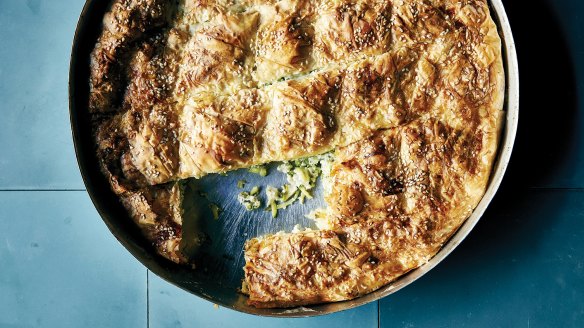
When Kathy Tsaples wrote her first cookbook, Sweet Greek, she was undergoing chemotherapy and anxious to pass on to her sons the family recipes that marked important occasions in the Greek calendar. Three years later, the Melbourne-born daughter of Greek migrants penned a follow-up, calling it Sweet Greek Life to celebrate surviving breast cancer and having the courage to give up her banking career to fulfil her dream of opening a food store.
The book, like her Prahran Market shop, Sweet Greek, is packed with generous, soulful dishes, some traditional, others new, but all made with simple but good ingredients. "Food is life. Food is love," says Tsaples. "I'm so grateful every day to be able to share the warmth and happiness that good food brings."
Easy zucchini, feta and ricotta pita (efkoli kolokithopita)
This recipe was inspired by a pita my mother would make. It is great to whip up for a quick weekday dinner.
INGREDIENTS
- 375g packet filo pastry
- 250g unsalted butter, melted
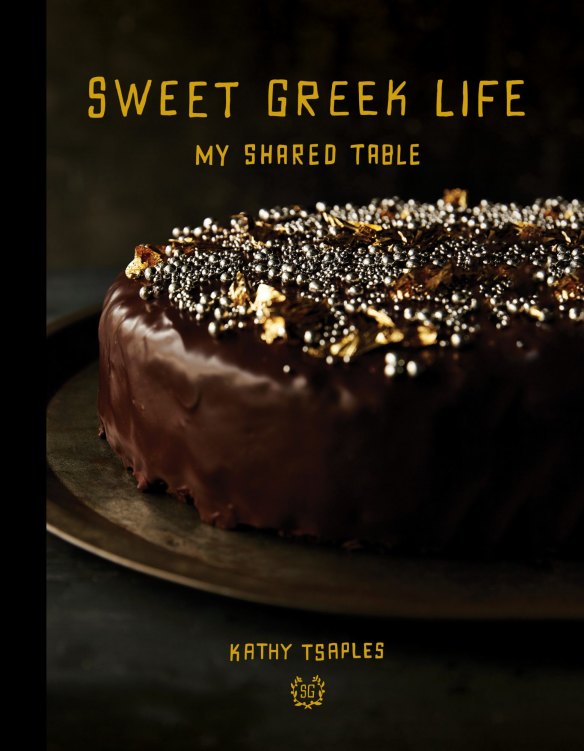
Filling
- 3 zucchinis, grated, sprinkled with 1 tsp of salt and left to drain in a colander
- 200g Greek feta, crumbled
- 300g fresh ricotta
- ½ cup thick Greek yoghurt
- 3 tbsp fresh mint, chopped
Topping
- 5 eggs
- 1 cup milk
- 1 cup thick Greek yoghurt
- 1 cup light olive oil or sunflower oil
- ½ tsp salt
- ½ tsp pepper
- sesame seeds
METHOD
- Brush a rectangular tray, about 36 x 30 centimetres, with some of the melted butter (see note). Remove the filo pastry from the packet and cover it with a damp cloth. Remove 4 sheets of pastry, lightly butter them and lay them crisscrossed on the bottom of the tray, with plenty of pastry coming out over the sides of the tray. These sheets will form the sides of the pita. Lightly butter 4 more sheets and place them on top of each other, then place them in the bottom of the tray to reinforce the bottom of the pita.
- To make the filling, thoroughly squeeze the excess liquid from the zucchinis. Combine with the feta, ricotta, yoghurt and mint in a large bowl. Season with pepper and salt, if needed.
- Set aside 3 sheets of filo for the top of the pita.
- Using a tablespoon, drop a few spoonfuls of the filling, here and there, onto the pastry base. Take the next sheet of filo and place it over the top, slightly ruffled, to create pockets of air that will make the pita more fluffy.
- Drip a little melted butter here and there over the top of the pastry using a pastry brush, and top with more of the zucchini mixture. Try to drip it in different areas of the pastry from the previous layer, again creating air pockets. Continue this layering process until the filling mixture is used.
- To seal the pita, fold the filo from the outside inward, then layer the final 3 sheets over the top, tuck it in around the edges and brush with melted butter. Use a sharp knife to cut the top layer of pastry into about 8-centimetre squares.
- To make the topping, whisk the eggs, milk, yoghurt and oil together, season with salt and pepper, and pour all over the pita. Leave to sit for about 30 minutes.
- Preheat the oven to 160C fan-forced (180C conventional).
- Sprinkle the pita with sesame seeds and bake for about 1 hour, or until both the top and bottom are golden.
Note: The trick to really crisp filo pastry is to brush on plenty of clarified butter. To clarify the butter, melt it over a low heat, skimming off and discarding the foamy milk solids that rise to the top. The melted butter will separate into butterfat and liquid. Use only the butterfat to brush the pastry as the liquid will make the pastry wet.
Serves: up to 10
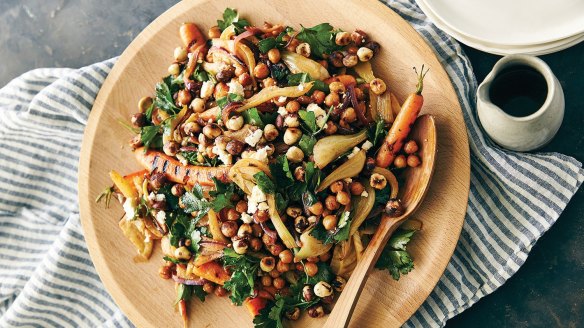
Roasted chickpea and fennel salad (salata me psita revithia, maratho ke karota)
Roasting chickpeas with paprika really transforms them. In fact, once roasted you could serve these chickpeas as they are, with a drink. This dish can be served alone as a lunch dish with some rustic bread, or as a substantial accompaniment to a main dish.
INGREDIENTS
- 2 × 400g cans chickpeas
- ¼ cup Greek extra virgin olive oil, plus an extra ⅓ cup
- 1 tsp smoky paprika
- 1 bunch baby carrots
- 2 small fennel bulbs
- 2 brown onions
- ½ cup whole hazelnuts, toasted
- 200g feta cheese, to serve
- 1 cup whole flat-leaf parsley leaves without stalks, to serve
Dressing
- 4 tbsp Greek extra virgin olive oil
- juice of 2 limes
- ½ tsp salt
- ¼ tsp pepper
METHOD
- Preheat the oven to 180C fan-forced (200C) and line a baking tray with baking paper.
- Drain and rinse the chickpeas and spread them out on the baking paper. Drizzle with the ¼ cup olive oil and sprinkle with paprika. Mix well with your hands to ensure the chickpeas are well-coated. Roast for about 20 minutes. Remove from the oven and set aside to cool.
- Top and tail the carrots, wash them and set aside. Halve the fennel bulbs and onions, then place the cut side down on the cutting board and thinly slice them lengthwise. Place them on a non-stick baking tray with the carrots and toss with the ⅓ cup olive oil. Roast vegetables for 20-30 minutes, turning occasionally to ensure they are caramelised all over. Remove from the oven.
- Add the chickpeas and hazelnuts to the roasted vegetables and toss well.
- Whisk all the dressing ingredients together, pour over the vegetables and toss well. Transfer to a serving dish and top with the feta and parsley leaves.
Serves: 4-6
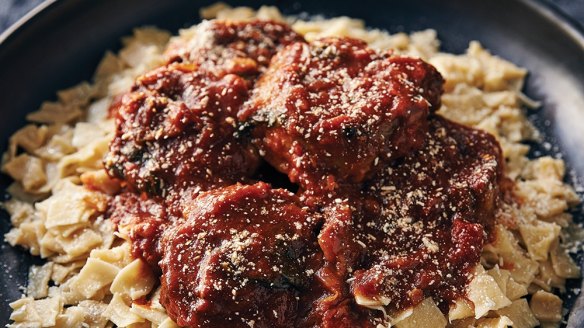
Slow-cooked lamb necks (katsarola me arnisia lemous)
Lamb necks are a wonderful, and often overlooked, cut of meat. They particularly remind me of my dad, who loved the soft, silky meat, always cooked slowly and falling off the bone. Lamb necks are a great alternative to lamb shanks. They can also be roasted on low heat with lemon juice and oregano. This is good served with the little pasta squares Greeks call hilopites.
INGREDIENTS
- 3 lamb necks (ask the butcher to cut them into 5-centimetre pieces)
- ⅓ cup Greek extra virgin olive oil
- 2 onions, finely diced
- 2 tbsp tomato paste
- 1 tsp sweet paprika
- ½ cinnamon stick
- 3 whole garlic cloves
- 5 whole allspice berries
- 3 bay leaves
- 400g can diced tomatoes
- 500ml chicken stock or water
- 1 tbsp red wine vinegar
- ½ bunch fresh basil to serve
METHOD
- Place the lamb in a large pot and cover with cold water. Bring to the boil, then remove from the heat and strain, discarding the water. Rinse the lamb in fresh water and set aside.
- Heat the olive oil in a large heavy-based pan. Add the onions and cook until softened. Add the lamb and turn up the heat to gently colour the meat. Add the tomato paste and stir through. Then add the sweet paprika, cinnamon stick, garlic, allspice berries and bay leaves, stir to combine, then add the diced tomatoes. Add the stock or water, ensuring it covers the meat by about 3 centimetres.
- Cover the pot and cook on very low heat for 2-3 hours, or until the meat is falling off the bone. This can also be done in the oven at 140C fan-forced (160C conventional). Towards the end of the cooking time, season with salt, pepper and the red wine vinegar. The tomato should reduce to a thick, rich sauce.
- Serve with the basil leaves torn roughly over the stew.
Serves: 4-6
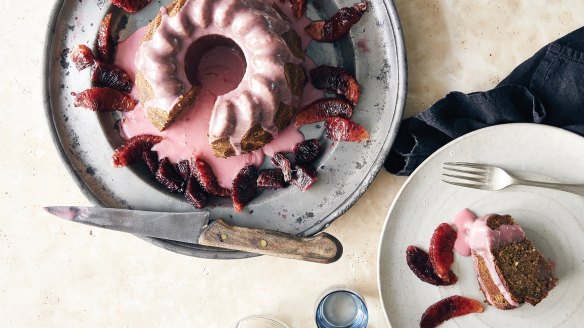
Blood orange cake (keik me portokali ke amigthalo)
This recipe is the result of my fascination with the vibrant colour of blood oranges. The cake's slight bitterness is balanced by the sweetness of the icing.
INGREDIENTS
Cake
- 3 blood oranges
- 5 eggs
- 250g castor sugar
- 250g almond meal, plus extra
- 1 tsp baking powder
- ¼ tsp salt
Icing
- 1 cup icing sugar
- 2-3 tbsp blood orange juice
METHOD
- Boil the oranges submerged in a saucepan of water for 1 hour, then drain and set aside to cool.
- Preheat the oven to 160C fan-forced (180C conventional).
- Butter a 20-centimetre round cake tin and sprinkle it with almond meal, flour or gluten-free flour if required.
- Pulse the oranges in a food processor to a fine puree. In a large bowl, whisk the eggs and sugar together. Add the orange pulp and mix thoroughly. Add the almond meal, baking powder and salt, and combine thoroughly.
- Leave the batter to rest for 10 minutes, then pour it into the prepared tin and bake for about 1 hour. When a skewer comes out clean it is ready. Remove from the oven and set aside to cool.
- To make the icing, sift the icing sugar into a small bowl and add the blood orange juice. Combine with a fork, making sure there are no lumps. Pour over the cooled cake.
Serves: 6-8
This is an edited extract from Sweet Greek Life, My Shared Table by Kathy Tsaples. Photographs by John Laurie. Published by Melbourne Books. RRP $49.95. Buy now